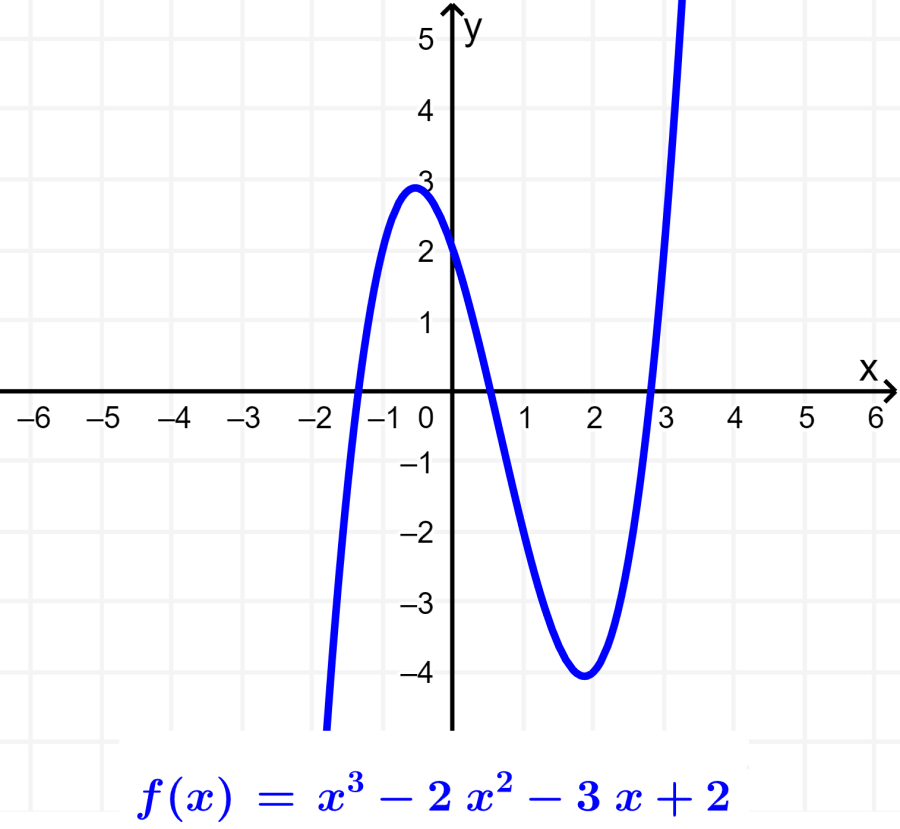Polynomial functions are functions that only have non-negative integer exponents of the independent variable. Some examples of polynomial functions are the linear function, the quadratic function, and the cubic function. The graphs of these functions vary depending on the degree of the function.
Here, we will look at a summary of polynomial functions along with their most important characteristics. In addition, we will look at several examples with answers to learn about its characteristics and its applications.
Summary of polynomial functions
A polynomial function is a function such as a quadratic, cubic, quartic, among others, that only has non-negative integer powers of x. A polynomial of degree n is a function that has the general form:
$$f(x)=a_{n}{{x}^n}+a_{n-1}{{x}^{n-1}}+…+a_{2}{{x}^2}+a_{1}x+a_{0}$$
where the coefficients a are all real numbers. Although the general form looks very complicated, the particular examples are simpler. For example,
$latex f(x)=2{{x}^3}+4{{x}^2}+2x$
is a polynomial function of degree 3 since 3 is the largest power of the function. And the function:
$$f(x)=-4{{x}^5}+2{{x}^4}+3{{x}^2}+6$$
is a polynomial function of degree 5 since 5 is the greatest power of the function.
Roots of polynomial functions
When we have $latex (x-a)(x-b)=0$, we know that a and b are the roots of the function $latex f(x)=(x-a)(x-b)$. Therefore, we can find the polynomial roots by forming an equation by setting the polynomial part of the function equal to zero and factoring or solving for x.
It is also possible to use the opposite of this. For example, if we have that a and b are roots, we know that the polynomial function with these roots must be $latex f (x) = (x-a)(x-b)$, or a multiple of this.
If $latex x=3$ and $latex x=-4$ are the roots of the polynomial function, then this function must be $latex f(x)=(x-3)(x+4)$, or a constant multiple of this.
Examples with answers of polynomial function problems
The following polynomial functions examples can be used to learn about the most common applications and problems that can be encountered with these functions.
EXAMPLE 1
Is the function $latex f(x)=-2+3{{x}^2}+2{{x}^3}$ a polynomial function?
Solution
We can see that the function $latex f(x)=-2+3{{x}^2}+2{{x}^3}$ only has variables with positive integer exponents, therefore, this function is polynomial.
EXAMPLE 2
Is the function $latex f(x)=-2{{x}^3}+5{{x}^2}+\sqrt{x}$ a polynomial function?
Solution
Taking into account that radicals can be written as fractional powers, we can write the function $latex f(x)=-2{{x}^3}+5{{x}^2}+\sqrt{x}$ as:
$latex f(x)=-2{{x}^3}+5{{x}^2}+{{x}^{\frac{1}{2}}}$
We see that not all exponents of the variable are positive integers. Therefore, this function is not an exponential function.
EXAMPLE 3
Write a polynomial function that has roots 2, 3, 5, 7.
Solution
When we have a polynomial written in the form $latex (x-a)(x-b)=0$, we know that its roots area and b. Therefore, we can find a factored polynomial using those roots. In this case, the roots are 2, 3, 5, and 7, so we have:
$latex f(x)=(x-2)(x-3)(x-5)(x-7)$
This means that the polynomial function that has the given roots is $$f(x)=(x-2)(x-3)(x-5)(x-7)$$ or a multiple of this polynomial. For example, $$f(x)=2(x-2)(x-3)(x-5)(x-7)$$ and $$f(x)=-5(x-2)(x-3)(x-5)(x-7)$$ are also polynomial functions that have the given roots.
EXAMPLE 4
Find a polynomial function that has roots -4, -2, 2, 4.
Solution
Here, we have the roots -4, -2, 2, 4, so the polynomial function that contains these roots is:
$$f(x)=(x+4)(x+2)(x-2)(x-4)$$
Therefore, the polynomial function is $$f(x)=(x+4)(x+2)(x-2)(x-4)$$ or a multiple of this function.
We always have to remember to correctly assign the signs to the constants of each factor. For example, if the root is -4, the factor is $latex (x + 4)$ and if the root is 4, the factor is $latex (x-4)$.
EXAMPLE 5
Write a polynomial function that has roots -5, -2, 1, 5, 6.
Solution
Similar to the previous exercises, we simply form factors with the given roots. Therefore, we have:
$$f(x)=(x+5)(x+2)(x-1)(x-5)(x-6)$$
This means that the polynomial function that has the roots -5, -2, 1, 5, 6 is the function $$f(x)=(x+5)(x+2)(x-1)(x-5)(x-6)$$ or a multiple of this function like $$f(x)=4(x+5)(x+2)(x-1)(x-5)(x-6)$$ or $$f(x)=-3(x+5)(x+2)(x-1)(x-5)(x-6)$$.
Polynomial function problems – Practice
Use the following problems to practice what you have learned about polynomial functions. Select an answer and check it to see if you chose the correct one.
See also
Interested in learning more about polynomials? Take a look at these pages:




